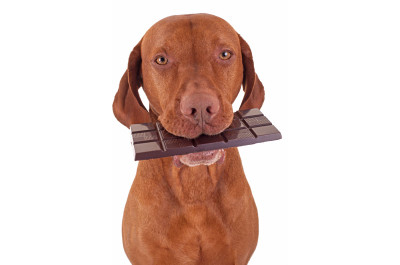Posted by Zena Conkey on Apr 09, 2020
For many children and families, Easter is an exciting time of year. Not only is a time often spent with family and friends but, for children, it is also a time for hunting Easter eggs and enjoying chocolate bunnies. In the midst of all the holiday frenzy, don’t forget about your dog!
Many dog owners like to give their dogs their own mini Easter basket filled with healthy treats and goodies but it is the treats you don’t give your dog that you have to worry about. At Easter time there is likely to be all kinds of chocolate and other sweets around the house where your dog could find and consume it. A few M&Ms may not harm your dog, but if he eats his way through your child’s Easter basket it could have serious side effects. To protect your dog this Easter, learn the basics about chocolate toxicity and how to prevent it.

Why is Chocolate Bad for Dogs?
Feeding your dog any kind of food intended for humans is dangerous because it could promote weight gain and may upset your dog’s stomach. There are certain foods like chocolate, however, that can actually harm or even kill your dog if ingested. Chocolate contains a chemical called theobromine. While humans are able to metabolize this chemical easily, a dog’s digestive system metabolizes the chemical much more slowly, spreading its effects over a longer period of time. A human who eats a bar of chocolate may experience a brief sugar rush lasting 20 to 30 minutes but a dog who consumes the same amount of chocolate could be experiencing the effects for days. In fact, after 17 hours as much as half the theobromine could still be present in your dog’s system.
While all chocolate is bad for dogs, certain kinds are more dangerous than others. The more theobromine the chocolate contains, the more toxic it is to dogs. White chocolate contains very little theobromine while an ounce of unsweetened baking chocolate contains almost 400 milligrams. A dose of theobromine as low as 115 milligrams per kilogram of body weight is all it takes to poison your dog. That means that a dog weighing about 20 pounds could be killed by eating 20 ounces of milk chocolate, 10 ounces of semi-sweet chocolate or 2 ¼ ounces of baking chocolate. Though doses this high are more likely to be fatal, even ingesting 100 to 150 milligrams of theobromine per kilogram of body weight can cause severe toxic reactions in dogs.
How Can You Tell if Your Dog Has Eaten Chocolate?
Aside from the shredded sweety wrappers, there are a few other things that might clue you in to the fact that your dog has consumed a toxic dose of chocolate. The most common reactions to chocolate poisoning include vomiting and diarrhea but severe chocolate toxicity can also cause elevated heart rate, seizures and hyperactivity or agitation. If you suspect that your dog has eaten chocolate and he begins to exhibit any of these symptoms, take him to the vet immediately. While there is no antidote for chocolate poisoning in dogs, the side effects can be treated with fluids and induced vomiting may be recommended to rid the dog’s body of the chocolate.
What to do if Your Dog Eats Chocolate
Your first step should be to call your veterinarian. Dogs typically exhibit signs of chocolate poisoning within four to twenty-four hours of ingesting the chocolate so it may not be immediately evident if your dog has been poisoned.
If your dog is showing symptoms of chocolate toxicity, take him to the vet immediately for treatment. The first step in treatment for severe chocolate poisoning is often induced vomiting followed by treatment with intravenous fluids and anti-seizure medications. Induced vomiting will help to remove the undigested chocolate from your dog’s body while the fluids and medication will serve to lower the heart rate and blood pressure. Your dog may also be given activated charcoal to help absorb the toxins remaining in your dog’s stomach. Following treatment for chocolate toxicity, your dog may need to be observed for 24 hours or more – your veterinarian may also recommend a follow-up exam.
Tips for Easter Safety
The key to preventing chocolate poisoning in dogs is to prevent them from having access to chocolate in the first place. This can be difficult if you have children in your home that may not be careful about where they leave their Easter eggs and sweets. Just to be safe, keep all chocolate and sweets safely tucked away in cabinets or closed containers where your dog can’t get to them. If you do plan to have an Easter egg hunt, confine your dog until all the eggs have been collected or keep him on a leash by your side so you can keep an eye on him. Be sure to warn your children about the dangers of dogs ingesting chocolate so they can take these precautions as well.
There is no reason why your dog cannot be a part of your Easter plans, you may just need to take a few precautions to ensure his safety. If you are conscious about keeping chocolate away from your dog, however, there should be no worries about everyone having a safe and happy holiday.
